Investigation of Process Control Influence on Tribological Properties of FLM-Manufactured Components
Abstract
:1. Introduction
2. Materials and Methods
2.1. Additively Manufactured PBT Tribo-Test Specimens
2.2. Determination of the Tribo-Contact Area
2.3. Quintuple Reciprocating Pin-On-Plate Tribo-Tester
3. Results and Discussion
3.1. Influence of Grinding Direction of the Metal Body and the Infill Orientation
3.2. Influence of the Infill Density on Tribological Properties
3.3. Results of the Definitive Screening Design
4. Conclusions
Author Contributions
Funding
Acknowledgments
Conflicts of Interest
References
- Lee, J.; Huang, A. Fatigue analysis of FDM materials. Rapid Prototyp. J. 2013, 19, 291–299. [Google Scholar] [CrossRef]
- Tymrak, B.M.; Kreiger, M.; Pearce, J.M. Mechanical properties of components fabricated with open-source 3-D printers under realistic environmental conditions. Mater. Des. 2014, 58, 242–246. [Google Scholar] [CrossRef]
- Lanzotti, A.; Grasso, M.; Staiano, G.; Martorelli, M. The impact of process parameters on mechanical properties of parts fabricated in PLA with an open-source 3-D printer. Rapid Prototyp. J. 2015, 21, 604–617. [Google Scholar] [CrossRef] [Green Version]
- Durgun, I.; Ertan, R. Experimental investigation of FDM process for improvement of mechanical properties and production cost. Rapid Prototyp. J. 2014, 20, 228–235. [Google Scholar] [CrossRef]
- Kotlinski, J. Mechanical properties of commercial rapid prototyping materials. Rapid Prototyp. J. 2014, 20, 499–510. [Google Scholar] [CrossRef]
- Cuan-Urquizo, E.; Barocio, E.; Tejada-Ortigoza, V.; Pipes, R.B.; Rodriguez, C.A.; Roman-Flores, A. Characterization of the Mechanical Properties of FFF Structures and Materials: A Review on the Experimental, Computational and Theoretical Approaches. Materials 2019, 12, 895. [Google Scholar] [CrossRef] [Green Version]
- Wu, W.; Geng, P.; Li, G.; Zhao, D.; Zhang, H.; Zhao, J. Influence of Layer Thickness and Raster Angle on the Mechanical Properties of 3D-Printed PEEK and a Comparative Mechanical Study between PEEK and ABS. Materials 2015, 8, 5834–5846. [Google Scholar] [CrossRef]
- Tanikella, N.G.; Wittbrodt, B.; Pearce, J.M. Tensile strength of commercial polymer materials for fused filament fabrication 3D printing. Addit. Manuf. 2017, 15, 40–47. [Google Scholar] [CrossRef] [Green Version]
- Findik, F. Latest progress on tribological properties of industrial materials. Mater. Des. 2014, 57, 218–244. [Google Scholar] [CrossRef]
- Boparai, K.; Singh, R.; Singh, H. Comparison of tribological behaviour for Nylon6-Al-Al 2 O 3 and ABS parts fabricated by fused deposition modelling. Virtual Phys. Prototyp. 2015, 10, 59–66. [Google Scholar] [CrossRef]
- Singh Boparai, K.; Singh, R.; Singh, H. Wear behavior of FDM parts fabricated by composite material feed stock filament. Rapid Prototyp. J. 2016, 22, 350–357. [Google Scholar] [CrossRef]
- Singh, R.; Singh, S.; Fraternali, F. Development of in-house composite wire based feed stock filaments of fused deposition modelling for wear-resistant materials and structures. Compos. Part. B: Eng. 2016, 98, 244–249. [Google Scholar] [CrossRef]
- Gurrala, P.K.; Regalla, S.P. Friction and wear behavior of abs polymer parts made by fused deposition modeling (FDM). Technol. Lett. 2014, 1, 13–17. [Google Scholar]
- Mohamed, O.A.; Masood, S.H.; Bhowmik, J.L.; Somers, A.E. Investigation on the tribological behavior and wear mechanism of parts processed by fused deposition additive manufacturing process. J. Manuf. Process. 2017, 29, 149–159. [Google Scholar] [CrossRef]
- Sood, A.K.; Equbal, A.; Toppo, V.; Ohdar, R.K.; Mahapatra, S.S. An investigation on sliding wear of FDM built parts. Cirp J. Manuf. Sci. Technol. 2012, 5, 48–54. [Google Scholar] [CrossRef]
- Kulkarni, M.V.; Elangovan, K.; Reddy, K.H.; Basappa, S.J. Tribological behaviours of abs and pa6 polymer-METAL sliding combinations under dry friction, water absorbed and electroplated conditions. J. Eng. Sci. Technol. 2016, 11, 68–84. [Google Scholar]
- Nagendra, J.; Ganesha Prasad, M.S. Comparison of tribological behavior of nylon aramid polymer composite fabricated by fused deposition modeling and injection molding process. Int. J. Mech. Mech. Eng. Technol. 2018, 9, 720–728. [Google Scholar]
- Lin, L.; Ecke, N.; Huang, M.; Pei, X.-Q.; Schlarb, A.K. Impact of nanosilica on the friction and wear of a PEEK/CF composite coating manufactured by fused deposition modeling (FDM). Compos. Part B Eng. 2019, 177, 107428. [Google Scholar] [CrossRef]
- Czichos, H.; Habig, K.-H. Tribologie-Handbuch; Springer Fachmedien Wiesbaden: Wiesbaden, Germany, 2015; ISBN 978-3-8348-1810-2. [Google Scholar]
- Georgescu, C.; Stefanescu, I.; Botan, M.; Deleanu, L. Friction and Wear of Polybutylene Terephthalate Against Steelin Block-on-ring-tests. Mater. Plast. 2012, 49, 151–156. [Google Scholar]
- Georgescu, C.; Botan, M.; Deleanu, L. Influence of Adding Materials in PBT on Tribological Behaviour. Mater. Plast. 2013, 51, 351–354. [Google Scholar]
- Lin, L.; Schlarb, A.K. The roles of rigid particles on the friction and wear behavior of short carbon fiber reinforced PBT hybrid materials in the absence of solid lubricants. Tribol. Int. 2018, 119, 404–410. [Google Scholar] [CrossRef]
- Jeng, M.-C.; Fung, C.-P.; Li, T.-C. The study on the tribological properties of fiber-reinforced PBT composites for various injection molding process parameters. Wear 2002, 252, 934–945. [Google Scholar] [CrossRef]
- Czichos, H.; Saito, T.; Smith, L.R. Springer Handbook of Materials Measurement Methods; Springer: Berlin/Heidelberg, Germany, 2006; ISBN 9783540207856. [Google Scholar]
- Martínez, F.J.; Canales, M.; Bielsa, J.M.; Jiménez, M.A. Relationship between wear rate and mechanical fatigue in sliding TPU–metal contacts. Wear 2010, 268, 388–398. [Google Scholar] [CrossRef]
- Mnif, R.; Ben Jemaa, M.C.; Kacem, N.H.; Elleuch, R. Impact of Viscoelasticity on the Tribological Behavior of PTFE Composites for Valve Seals Application. Tribol. Trans. 2013, 56, 879–886. [Google Scholar] [CrossRef]
- Casey, M.; Wilks, J. The friction of diamond sliding on polished cube faces of diamond. J. Phys. D Appl. Phys. 1973, 6, 1772–1781. [Google Scholar] [CrossRef]
- Stupkiewicz, S.; Lewandowski, M.J.; Lengiewicz, J. Micromechanical analysis of friction anisotropy in rough elastic contacts. Int. J. Solids Struct. 2014, 51, 3931–3943. [Google Scholar] [CrossRef] [Green Version]
- Yu, C.; Yu, H.; Liu, G.; Chen, W.; He, B.; Wang, Q.J. Understanding Topographic Dependence of Friction with Micro- and Nano-Grooved Surfaces. Tribol. Lett. 2014, 53, 145–156. [Google Scholar] [CrossRef]
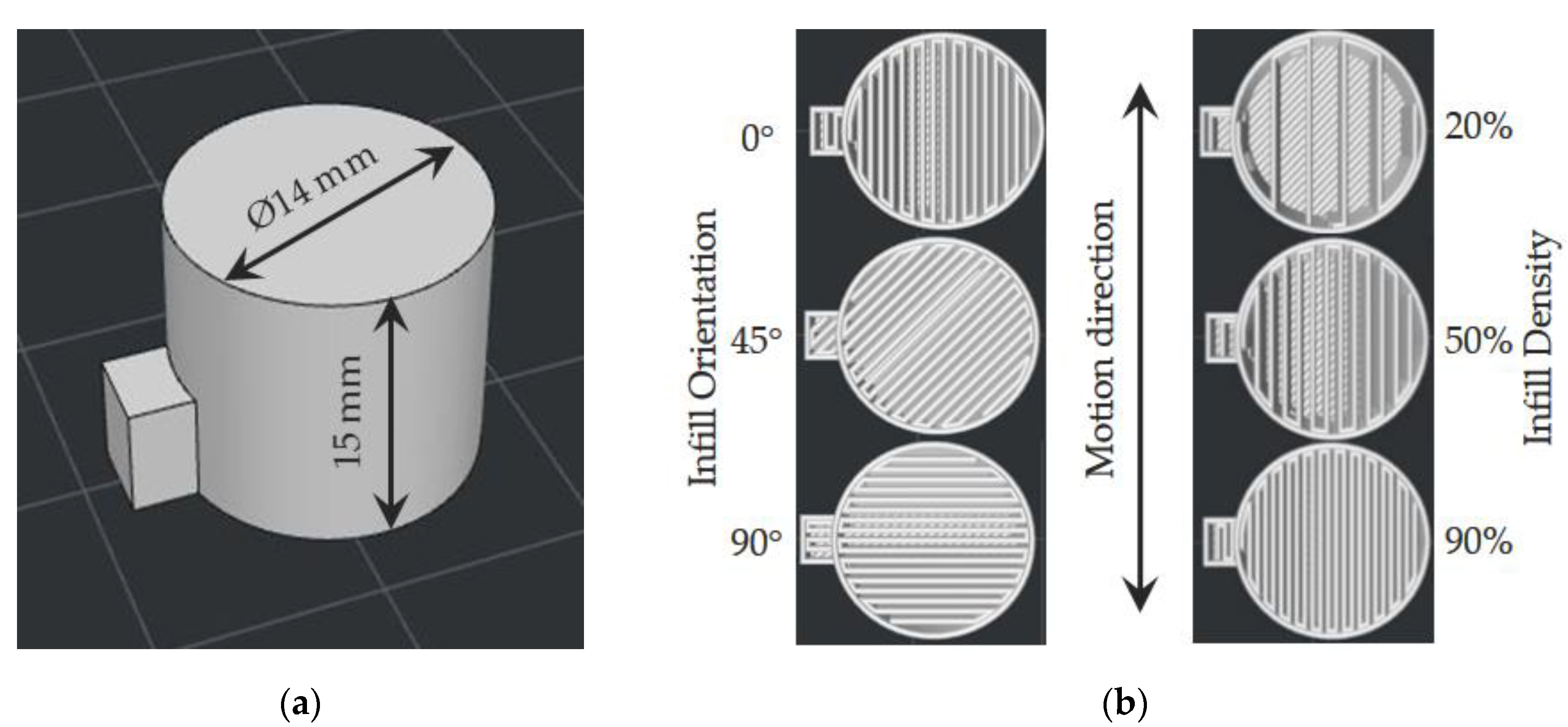


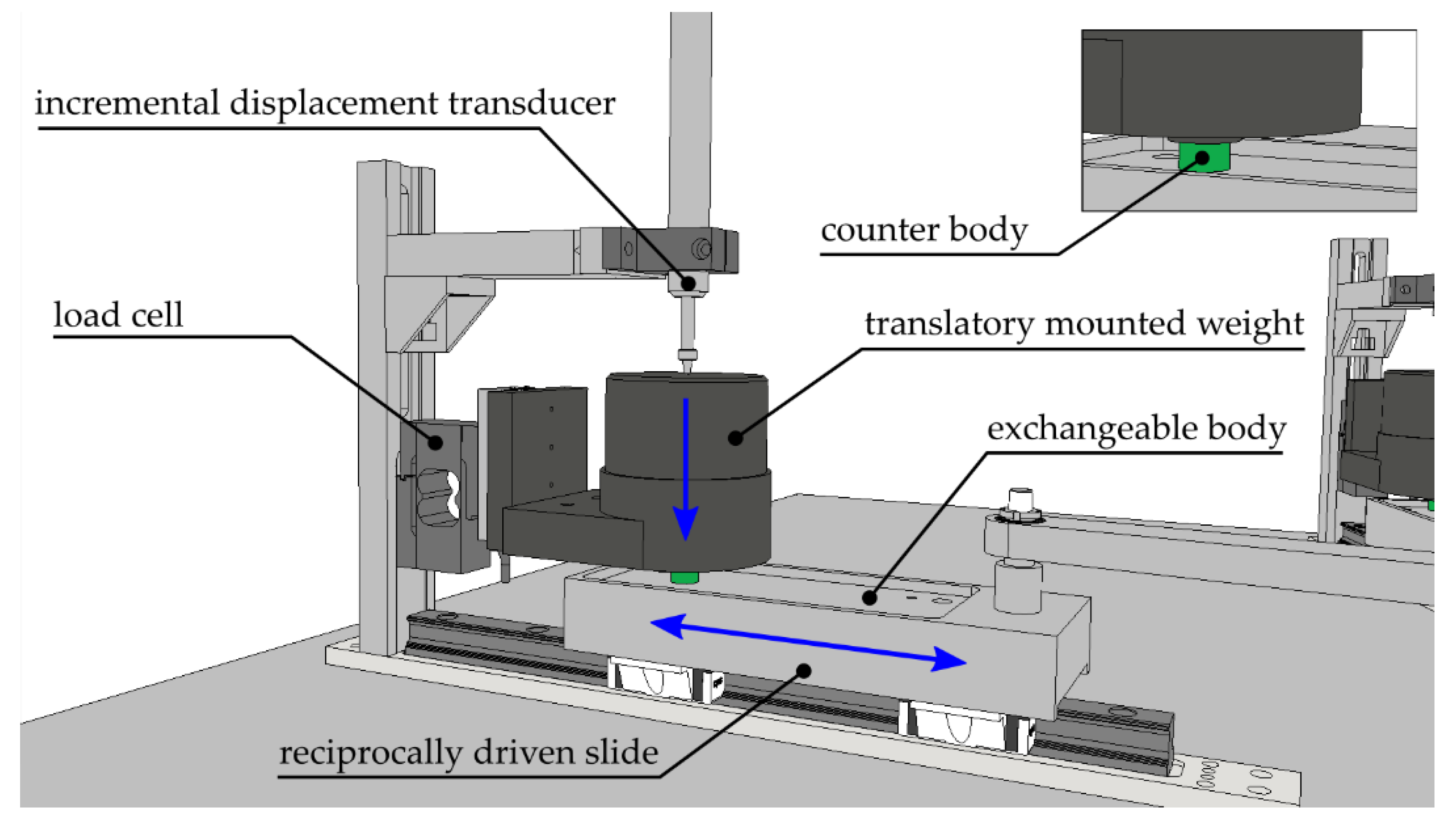


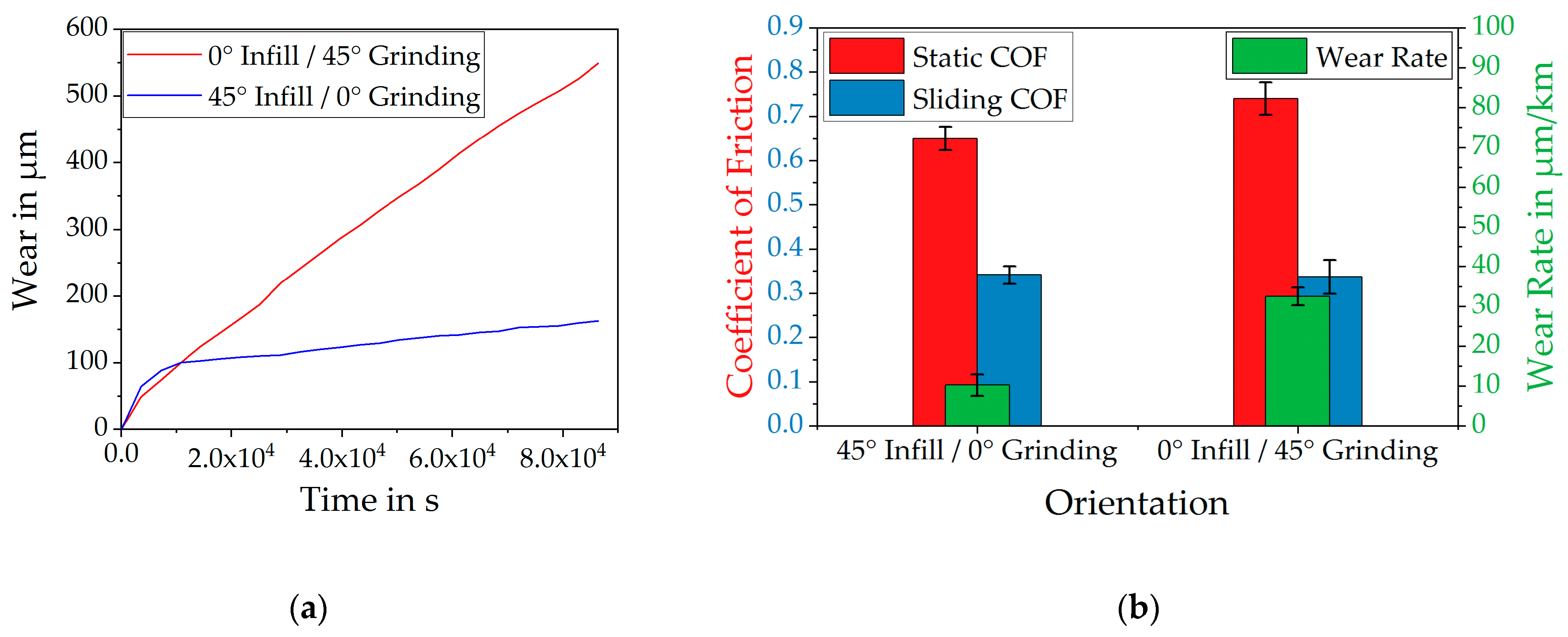

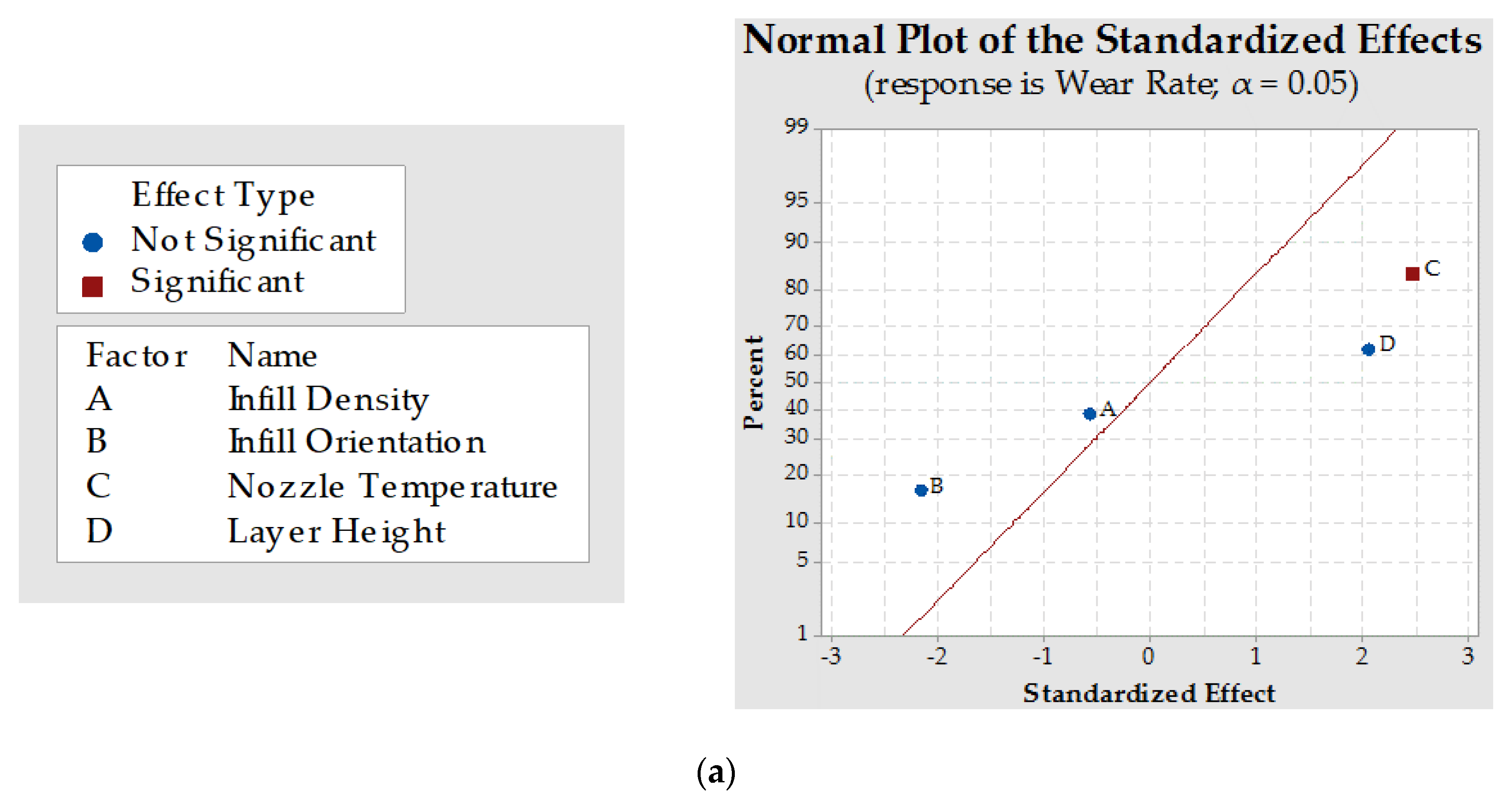
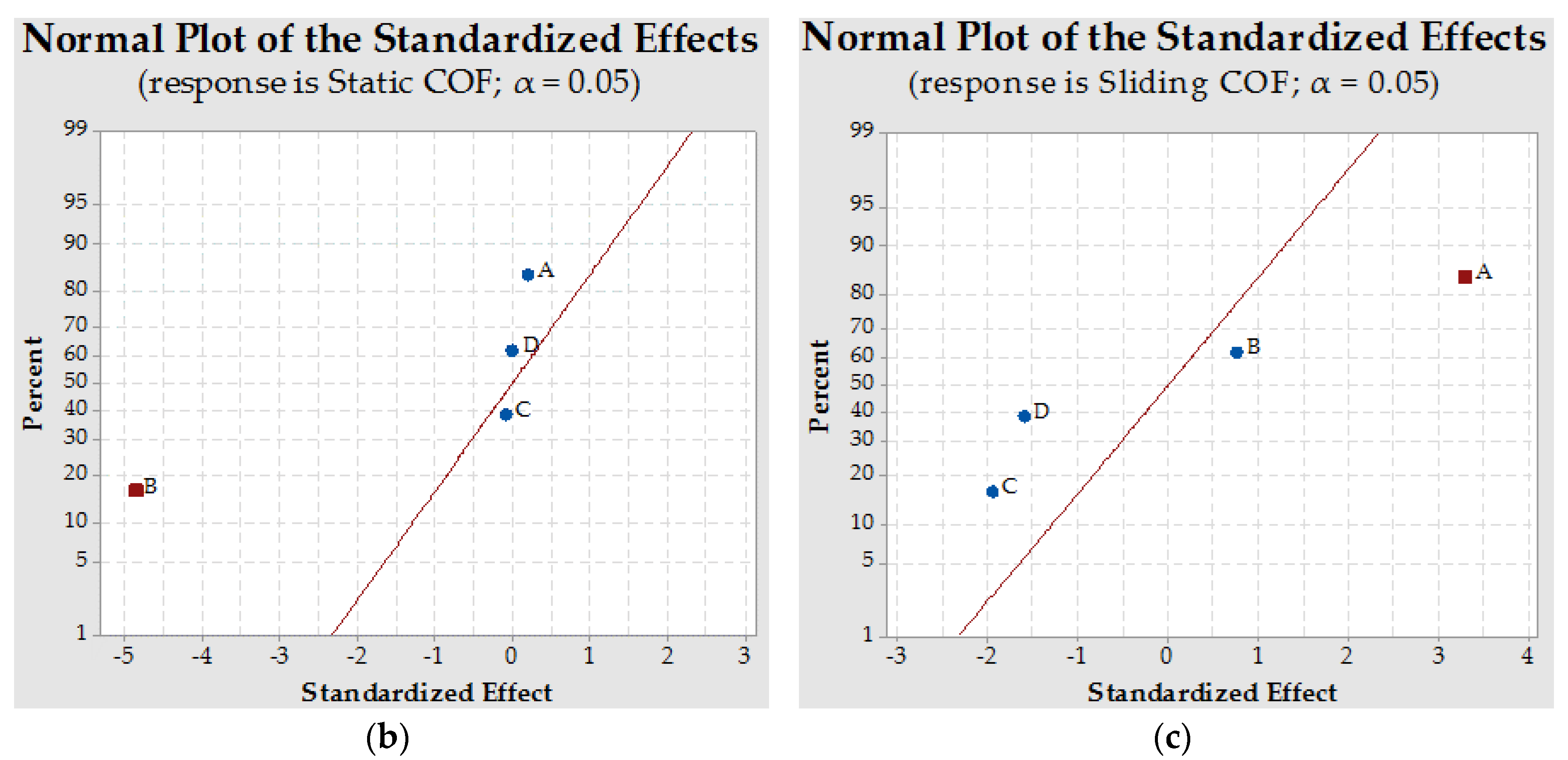

| Process Parameter | Value | ||||||
|---|---|---|---|---|---|---|---|
| Unit | Symbol | Level | |||||
| Preliminary Tests | Screening DSD | ||||||
| 1 | 2 | Low | Centre | High | |||
| Infill Density | % | A | 60 | 20–100 | 70 | 80 | 90 |
| Infill Orientation | deg | B | 45-0 | 0 | 0 | 45 | 90 |
| Nozzle Temperature | °C | C | 250 | 250 | 250 | 270 | 290 |
| Layer Height | mm | D | 0.20 | 0.20 | 0.15 | 0.20 | 0.25 |
| Grinding Orientation | deg | 0-45 | 0 | 0 | 0 | 0 | |
| Infill Density | Contact Area | Surface Pressure |
|---|---|---|
| 20% | 51.88 mm2 | 0.951 MPa |
| 30% | 75.66 mm2 | 0.646 MPa |
| 40% | 92.38 mm2 | 0.526 MPa |
| 50% | 105.78 mm2 | 0.461 MPa |
| 60% | 119.19 mm2 | 0.409 MPa |
| 70% | 130.82 mm2 | 0.370 MPa |
| 80% | 134.70 mm2 | 0.362 MPa |
| 90% | 136.56 mm2 | 0.359 MPa |
| 100% | 138.04 mm2 | 0.355 MPa |
| Test Parameter | Value |
|---|---|
| Test Conditions | 23 °C and 50% humidity (climate-controlled lab) |
| Test Frequency | 1 Hz |
| Test Speed | 0.2 m/s |
| Normal Force | 50 N |
| Run | A % | B deg | C °C | D mm | Wear Rate µm/km | Static COF | Sliding COF |
|---|---|---|---|---|---|---|---|
| 1 | 70 | 90 | 250 | 0.20 | 11.20 ± 1.38 | 0.52 ± 0.02 | 0.31 ± 0.04 |
| 2 | 70 | 45 | 250 | 0.25 | 11.87 ± 1.09 | 0.62 ± 0.01 | 0.32 ± 0.03 |
| 3 | 70 | 90 | 290 | 0.15 | 11.71 ± 0.33 | 0.54 ± 0.05 | 0.31 ± 0.03 |
| 4 | 80 | 0 | 250 | 0.15 | 14.43 ± 1.21 | 0.68 ± 0.03 | 0.33 ± 0.02 |
| 5 | 90 | 90 | 250 | 0.15 | 10.58 ± 0.95 | 0.61 ± 0.02 | 0.38 ± 0.03 |
| 6 | 90 | 90 | 270 | 0.25 | 9.83 ± 2.05 | 0.58 ± 0.02 | 0.34 ± 0.03 |
| 7 | 80 | 45 | 270 | 0.20 | 10.87 ± 1.21 | 0.60 ± 0.02 | 0.33 ± 0.03 |
| 8 | 70 | 0 | 290 | 0.25 | 30.15 ± 1.38 | 0.68 ± 0.07 | 0.31 ± 0.02 |
| 9 | 90 | 0 | 290 | 0.20 | 20.94 ± 1.94 | 0.66 ± 0.03 | 0.32 ± 0.01 |
| 10 | 70 | 0 | 270 | 0.15 | 15.52 ± 1.93 | 0.71 ± 0.04 | 0.33 ± 0.02 |
| 11 | 90 | 45 | 290 | 0.15 | 13.22 ± 1.87 | 0.59 ± 0.02 | 0.33 ± 0.04 |
| 12 | 90 | 0 | 250 | 0.25 | 17.76 ± 1.49 | 0.65 ± 0.01 | 0.34 ± 0.01 |
| 13 | 80 | 90 | 290 | 0.25 | 24.86 ± 4.25 | 0.60 ± 0.04 | 0.32 ± 0.02 |
© 2020 by the authors. Licensee MDPI, Basel, Switzerland. This article is an open access article distributed under the terms and conditions of the Creative Commons Attribution (CC BY) license (http://creativecommons.org/licenses/by/4.0/).
Share and Cite
Hesse, D.; Stanko, M.; Hohenberg, P.; Stommel, M. Investigation of Process Control Influence on Tribological Properties of FLM-Manufactured Components. J. Manuf. Mater. Process. 2020, 4, 37. https://doi.org/10.3390/jmmp4020037
Hesse D, Stanko M, Hohenberg P, Stommel M. Investigation of Process Control Influence on Tribological Properties of FLM-Manufactured Components. Journal of Manufacturing and Materials Processing. 2020; 4(2):37. https://doi.org/10.3390/jmmp4020037
Chicago/Turabian StyleHesse, Daniel, Michael Stanko, Patrick Hohenberg, and Markus Stommel. 2020. "Investigation of Process Control Influence on Tribological Properties of FLM-Manufactured Components" Journal of Manufacturing and Materials Processing 4, no. 2: 37. https://doi.org/10.3390/jmmp4020037





